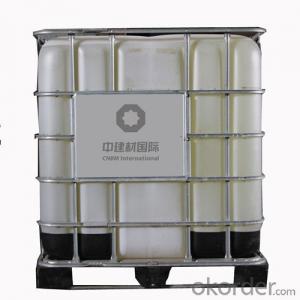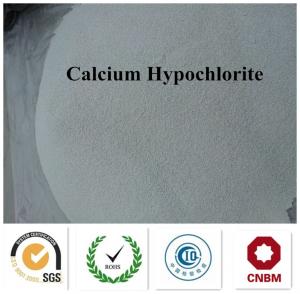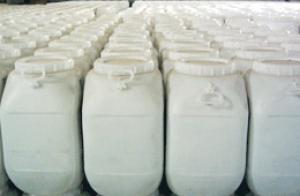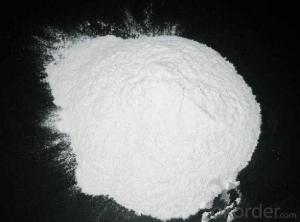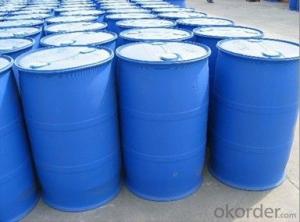Sodium Gluconate Retarder Liquid for Concrete
- Loading Port:
- China main port
- Payment Terms:
- TT OR LC
- Min Order Qty:
- 1000 kg
- Supply Capability:
- 500000 kg/month
OKorder Service Pledge
OKorder Financial Service
You Might Also Like
| Sodium Gluconate Retarder Liquid for Concrete |
Description: Technical Index: Q/140700RHP001-2007 Molecular Formula: C6H11NaO7 Molecular Weight: 218.1371
White or light yellow liquid Application 1). Because sodium gluconate has excellent effects of corrosion and scale proof,it is widely used as water stabilizer 2). Sodium gluconate can be used in Steel surface cleaning agent. 6).Sodium gluconate are Used for medicine
ItemIndexIndustrial GradePropertyWhite or light yellow liquid content≥ 30 %Chlorites≤ 0.1 %Sulphate≤ 0.05 %Restore objects1.0—1.5 %Lead≤ 0.001 %Heavy metal≤ 0.002 %. FAQ 1.Q: What is MOQ? A: Our MOQ is 1 TON. 2.Q: Could you offer free sample? A: We can provide free samples to you for quality testing. 3.Q: What about your packing? A: For liquid: Flexitank, or IBC tank 1000L For powder:Woven fabric bag with plastic film liner( 25kg or 1000kg) Clients’ packing is workable. 4.Q: How about your productive capacity? A: 150000 tons/Year. 5.Q: What is your delivery time? A: Within 7 days after received deposit or L/C at sight. |
- Q: The stronger the transpiration is, the faster the absorption rate of inorganic salts and water is
- Due to dry conditions are not complete, the lack of text, can not be a normal answer.
- Q: Does the inorganic salt fight the mass spectrum?
- Can it be specific? What mass spectrometer, which inorganic salts. Do EI need samples can be vaporized, inorganic salts obviously not appropriate
- Q: Is the conduction of excitement on neurons related to inorganic salts?
- Neurons, also known as nerve cells, constitute the basic unit of the nervous system structure and function.
- Q: Do inorganic mercury salts bioaccumulate?
- Yes they do bioaccumulate. Mercury builds up for years and years, and eventually sits in a residue of pure mercury. - JJ
- Q: Octopus why the lack of boron-containing inorganic salts can cause rape to flow only without fruit
- When the boron deficiency occurs, pollen tube germination is affected and poor fertilization leads to seed formation.
- Q: Which crop feet can provide C N inorganic salts for fungal growth
- Plant growth requires a variety of inorganic salts, which require the most is nitrogen, phosphorus, potassium containing inorganic salts. If a lack of some inorganic salts, plants can not grow normally. Kind of crops need fertilization, farm manure contains organic matter, the microbial decomposition of the soil will produce a large number of inorganic salts for plant growth and utilization, the role of fertilizer is to provide a variety of plant growth of inorganic salts. Therefore, in agricultural production, the application of fertilizer and farm manure is intended to provide a variety of inorganic salts for crops.
- Q: Magnesium can constitute chlorophyll, which reflects the nature of inorganic salts
- , to maintain the osmotic pressure of cells, especially for the absorption of nutrients in plants have an important role.
- Q: What are the disadvantages of inorganic salt deficiency and too much
- The role of inorganic salts in plant life Plants require the most inorganic salts to be nitrogen-containing, phosphorus-containing and potassium-containing inorganic salts. These three types of inorganic salts have different effects in plant life. Lack of performance nitrogen: to promote cell division and growth, so that leaves grow lush. Lack of performance: plant thin and thin, leaves yellow, severe leaves were light brown. P: Promote the development of seedlings and the opening of flowers so that the fruit and seed are mature early. Lack of performance: the plant is particularly short, leaves were green, and purple. Potassium: Stable stem to promote starch formation. Lack of performance: stems weak, easy to lodging, leaves the edge and the tip was brown, and gradually dry. In addition to these three types of inorganic salts, plants also require many types of inorganic salts. Among them, the demand for some inorganic salts is very small, but they are in the life of the plant also plays a very important role. For example, the lack of iron-containing inorganic salts, fruit trees will be yellow leaf disease; lack of boron-containing inorganic salts, rape will be "spent" (only flowering fruit)
- Q: General identification method of inorganic salts
- Take platinum wire, with hydrochloric acid wet, dipped in the test sample, burning in the colorless flame, the flame that was purple. But a small amount of sodium mixed, must be separated from the blue glass perspective can be identified. 2K ++ [PtCI6] 2- → K2PtCI6
- Q: A. food gathering and digestion B. photosynthesis and diatom structures C. reproduction and osmosis D. wave and current motions
- its not a so try b or c those 2 are the most likely to be the right answers
Send your message to us
Sodium Gluconate Retarder Liquid for Concrete
- Loading Port:
- China main port
- Payment Terms:
- TT OR LC
- Min Order Qty:
- 1000 kg
- Supply Capability:
- 500000 kg/month
OKorder Service Pledge
OKorder Financial Service
Similar products
Hot products
Hot Searches
Related keywords

